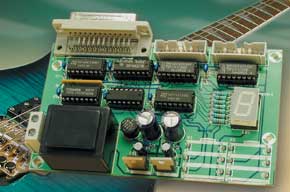Guitar Effects Switchbox

This is a MEMBER ONLY article. You need a subscription to read this article.
- Unlimited access to online Member Only articles
- 3 new editions Elektor Magazine (digital)
- More than 5000 Gerber files
- 20% member discount on e-books (at elektor.com)
- 10% member discount on Products (at elektor.com)
Available from €5.33 per month.
What is Members Only
Elektor is committed to providing high-quality content on electronics, catering to tens of thousands of paying members. As part of this commitment, Elektor has launched Premium, an initiative that offers exclusive online articles to members sometimes even before they appear in the magazine.
Every day, members can access in-depth articles that showcase the best of Elektor's premium content.
This initiative aims to reward members with early access. Once logged in, members can easily enjoy this exclusive content and engage in discussions about featured projects. While Premium adds to the existing resources available, Elektor will continue to provide a wealth of free information.
Join the Elektor community today to take advantage of Premium and other benefits!
Materials
Gerber file
CAM/CAD data for the PCB referred to in this article is available as a Gerber file. Elektor GREEN and GOLD members can exclusively download these files for free as part of their membership. Gerber files allow a PCB to be produced on an appropriate device available locally, or through an online PCB manufacturing service.
Elektor recommends the Elektor PCB Service service from its business partner Eurocircuits or AISLER as the best services for its own prototypes and volume production.
The use of our Gerber files is provided under a modified Creative Commons license. Creative Commons offers authors, scientists, educators and other creatives the freedom to handle their copyright in a more free way without losing their ownership.
Component list
Resistors:
R1 = 8-way SIL array, 10k?
R2-R8 = 680?
Capacitors:
C1,C2,C7-C15 = 100nF radial
C3,C4 = 1000µF 25V radial
C5,C6 = 10µF 16V radial
Semiconductors:
B1 = B80C1500 bridge rectifier in round case (80V piv, 1.5A)
IC1 = 74HC148
IC2 = 74HC173
IC3 = 74HC138
IC4,IC5 = 4051 or MAX4617*
IC6 = 74HC04
IC8 = 7805
IC9 = 7905
LD1 = 7-segment display with common cathode (e.g., HD1133O, Siemens)
Miscellaneous:
K1 = 25-way sub-D socket (female), PCB mount, angled pins
K2,K5 = mono jack socket, 6.35 mm, PCB mount
K3,K4 = 16-way boxheader
K6 = 2-way PCB terminal block, lead pitch 7.5mm
Tr1 = mains transformer
2×9V/2.6VA (Hahn BV EI 303 2016)
IEC mains appliance inlet with integrated fuse holder
16 mono jack sockets, 6.35mm, chassis mounting
PCB, order code 020181-1
Footswitch
Semiconductors:
D1-D8 = LED, 3mm, low current
Miscellaneous:
K1 = 25-way sub-D plug (male)
S1-S8 = footswitch (e.g., Monacor/Monarch FS-10)



Discussion (0 comments)